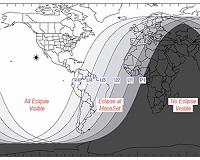 |
Reykjavik (AFP) Dec 21, 2010 Skygazers with a clear view in North America and Europe were greeted with a celestial treat early Tuesday, as a unique total lunar eclipse turned the Moon pink, coppery or even a blood red. Coinciding eerily with the northern hemisphere's mid-winter solstice -- for the first time in almost four centuries -- the eclipse showed the Sun, the Earth and its satellite as they directly aligned, with the Moon swinging into the cone of shadow cast by its mother planet. Despite being in shadow, the Moon did not become invisible, as there was still residual light deflected towards it by our atmosphere. Most of this refracted light is in the red part of the spectrum and as a result the Moon, seen from Earth, turned a reddish, coppery or orange hue, sometimes even brownish. At 0741 GMT -- the official start time of the eclipse -- a small crowd stood amazed in a Reykjavik parking lot as the moon appeared bright red in the Icelandic sky. "We couldn't be happier with the weather here -- a clear sky is ideal as you can see. I'm always in awe seeing that big red Moon hanging over us," said 30-year-old Saevar Helgi Bragason, the chairman of the Icelandic Amateur Astronomical Society. The society had set up a telescope for the 30 or so people who braved the bitter cold to observe the Moon and stars. "I've seen a solar eclipse here in Iceland, but this is something else. Absolutely magnificent," said Torfi Olafur Sverrisson, a bank IT worker in his 40s witnessing a lunar eclipse for the first time. "This is incredible, especially being able to view it up-close (thanks to the telescope) and not only the Moon, but Saturn as well," 35-year old Bergny said. Bragason explained that although lunar eclipses happened every two or three years, few had ever seen one. "We wanted to give people the chance to view this lunar eclipse through a telescope because not many people have ever seen this happen, even if it's quite common," he told AFP. "We'll see it again here in Iceland in two years for example," he said. But the fact that the eclipse fell on the exact date of the winter solstice is an extremely rare occurrence and it will only happen next in December 21, 2094, according to Geoff Chester of the US Naval Observatory, quoted by NASA. The last time it happened was on December 21, 1638. The eclipse ran for three and a half hours, starting with a chunk being slowly eaten out at 0633 GMT and the stage of total eclipse -- when the Moon heads into the "umbra" cast by the Earth -- lasting from 0741 to 0853 GMT. It lasted until 1001 GMT. Hundreds of Internet users uploaded their own photos of the darkened, color-tinged moon to go with NASA's and other space website moon close-ups. In the United States, some voiced their amazement, and others their disappointment, on social networking sites. "Just got up to see the eclipse, and it's unbelievable. I've been saying 'Oh, wow' over & over," wrote Shonali Burke on micro-blogging Twitter site from Washington. Sarcastically thanking the overcast Los Angeles "for blocking the first lunar eclipse on the Winter Solstice in 372 years," Twitter user Cory Parker added: "Guess I'll just catch the next one..." NASA's veteran eclipse expert Fred Espenak explained that while the entire event was visible from North America, Greenland and Iceland, western Europe saw the beginning stages before moonset and western Asia got the later stages after moonrise. The last total lunar eclipse took place on February 21 2008. Next year, says Espenak, will see two: on June 15 and December 10. A solar eclipse happens when the Moon swings between the Earth and the Sun, the next partial one will take place on January 4. burs-str/nl
Share This Article With Planet Earth
Related Links Solar and Lunar Eclipses at Skynightly
 Solstice Lunar Eclipse
Solstice Lunar EclipseHuntsville AL (SPX) Dec 20, 2010 Everyone knows that "the moon on the breast of new-fallen snow gives the luster of mid-day to objects below." That is, except during a lunar eclipse. The luster will be a bit "off" on Dec. 21st, the first day of northern winter, when the full Moon passes almost dead-center through Earth's shadow. For 72 minutes of eerie totality, an amber light will play across the snows of North America ... read more |
|
| The content herein, unless otherwise known to be public domain, are Copyright 1995-2010 - SpaceDaily. AFP and UPI Wire Stories are copyright Agence France-Presse and United Press International. ESA Portal Reports are copyright European Space Agency. All NASA sourced material is public domain. Additional copyrights may apply in whole or part to other bona fide parties. Advertising does not imply endorsement,agreement or approval of any opinions, statements or information provided by SpaceDaily on any Web page published or hosted by SpaceDaily. Privacy Statement |